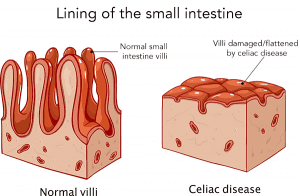If that happens, a child can become malnourished. Celiac disease — also known as celiac sprue, gluten-sensitive enteropathy, and non-tropical sprue — can lead to a wide variety of symptoms in different people.
Left Untreated, Celiac Disease Can Result in Serious Complications – Mayo Clinic News Network
Infants may not gain weight and height as expected a condition called failure to thrive. Older kids can have diarrhea, abdominal pain and bloating, weight loss, fatigue, or painful skin rashes. Some people who have celiac disease have no symptoms at all. Doctors don't know for sure what triggers the immune system to react to gluten in people who have celiac disease.
There is no cure, although researchers are working on developing enzyme pills to help with the digestion of the toxic part of gluten that causes intestinal damage. If your child is diagnosed with celiac disease, there are ways to minimize symptoms and any damage to the intestines. Symptoms of celiac disease can happen at any time in a child's life. Some kids have symptoms the first time they are exposed to gluten, while others develop symptoms after safely consuming gluten products for years.
Skin rashes also might appear, especially around the elbows, buttocks, and knees. Over time, the child might develop anemia and mouth sores, and become withdrawn or irritable. The causes of celiac disease are unknown. It has been linked to other health conditions, including Down syndrome, Diabetes mellitus, Williams syndrome, thyroid disorders, and selective immunoglobulin IgA deficiency.
Celiac disease tends to run in families, so if there is a family history of celiac disease, a child may have a higher risk of developing it. If one child is diagnosed with celiac disease, his or her siblings, parents, and grandparents should be tested too, as they may have the disease but no symptoms. Celiac disease that goes undiagnosed in adults for a long time can lead to serious health problems. Diagnosing celiac disease usually begins with a simple blood test that measures the level of antibodies to gluten and other proteins in the lining of the intestine.
If high levels of these antibodies are found, the doctor will likely order a biopsy of the small intestine and send it to a laboratory for testing. Doctors take this tissue sample by inserting a long, thin tube called an endoscope through the mouth and stomach into the small intestine. A child is usually moderately sedated or given general anesthesia for the procedure.
Losing Weight on a Gluten-Free Diet
Because these changes will greatly affect your family's everyday life and your child's diet, the doctor may suggest that you meet with a nutritionist for advice. Wheat, barley, rye, and related grains should be eliminated from your child's diet. But because there's no law requiring food manufacturers to list gluten on food labels , this can be difficult. In general, it's wise to stay away from foods that contain these gluten-related ingredients:.
It is generally safe for kids with celiac disease to eat oats that come from an uncontaminated source. That means that the oats have been processed in a mill that doesn't process grains that contain gluten on the same equipment. The label on the package of oats should clearly state if that's the case.
- Celiac Disease Foundation;
- lose weight with french wine!
- best zone for burning fat!
To avoid gluten — and prevent triggering your child's celiac symptoms — it's important to carefully read the labels of all foods before you buy them or let your child consume them. And help your child learn to do it too. When in doubt, the safest thing to do is to assume the product contains gluten and leave it out. In the United States, all foods must be clearly labeled if they contain any of the top eight food allergens, including wheat.
People with celiac disease aren't limited to eating at home. With experience and knowledge, you'll be able to figure out which dishes at restaurants or friends' homes contain gluten. A local support group might have a list of restaurants where the chef is familiar with the gluten-free diet. Some restaurants now offer gluten-free dishes on their menus — be sure to ask. In children, symptoms can appear as early as 6 months old. Irritability is a common symptom in children. If you think your child may have celiac disease, contact your pediatrician immediately.
Find out more about symptoms of celiac disease in children here. Diarrhea, steatorrhea, weight loss or growth failure is required. Examples of classical celiac disease are patients with diarrhea and weight loss but also patients with weight loss and anemia. Those with non-classical celiac disease present without signs and symptoms of malabsorption.
In non-classical celiac disease the patient does not suffer from malabsorption e. Patients with monosymptomatic disease other than diarrhea or steatorrhea usually have non-classical celiac disease. There are also what is known as asymptomatic or silent celiac disease , which is when someone with celiac disease as no outward symptoms.
Symptoms of coeliac disease
It is unclear why some people have symptoms while others do not. What Is Gluten? Monthly Newsletter Newsletter Archives. For Press and Media Glossary. What is Celiac Disease?
